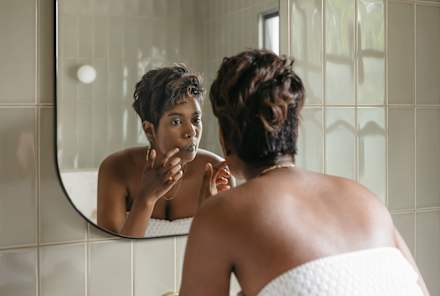Advertisement
What Does It Mean To Be Panromantic? Sexuality Experts Explain


For some people, gender plays an important role when it comes to choosing romantic partners, but this isn't the case for people who are panromantic. Below, we dive into what it means to be panromantic, how it relates to pansexuality and other identities, and more.
What does it mean to be panromantic?
The prefix pan- in panromantic means "all," "completely," or "involving all." That said, being panromantic means you experience romantic attraction or deep emotional connection, affection, or love for people of all genders. A panromantic person will typically be attracted to others regardless of sex or gender.
"Of course, this doesn't imply that panromantic people are romantically attracted to just about everyone out there. It's just that gender is the last thing that comes to their mind [when it comes to] whether or not they develop feelings for someone," says Dainis Graveris, a sex educator and founder of Sexual Alpha. "No one is off the table when it comes to who they're romantically attracted to."
He adds that people of any gender can be panromantic, and they can be romantically attracted to cis and trans folks, as well as nonbinary, gender fluid, genderqueer, and other gender-nonconforming individuals.
Additionally, Graveris notes it's important to differentiate between the "panromantic" and "pansexual" terms. In particular, the former is a type of romantic attraction, while the latter is a type of sexual attraction. (We'll dive more into that later.)
Understanding the different types of attraction
Through the lens of the Split Attraction Model, attraction comes in many forms, including sexual and romantic. By discerning among them, we can better explore, direct, and enjoy our various interactions with people, says Ley Cray, Ph.D., director of LGBTQIA+ programming at virtual mental health clinic Charlie Health.
So, what's the difference between sexual attraction and romantic attraction? Sexual attraction is perhaps the easiest to explain, says Cray: You see someone, and you experience a psychological and biological response indicating to you that you'd like to engage in sexual activity with that someone. On the other hand, romantic attraction is a little harder to explain, since the widespread notion of romance we see today is a cultural construct—and in the context of human history, a relatively recent one.
"Historically, the concept has connections to the notion of courtship and at bare minimum seems to involve some desire to connect on an emotional level, with some variety of intimacy and reciprocal commitment. Some might argue that the concept even presupposes some sense of romanticizing—that is, idealizing—the person you're attracted to," Cray explains.
It's important to note that not all sexual attractions are romantic attractions and not all romantic interests are coupled with a sexual attraction.
"Some folks might identify as asexual but still experience romantic attraction to folks regardless of their gender identity," adds sex and relationship coach Azaria Menezes. "Someone who might identify as heterosexual may feel romantic attraction toward others regardless of their gender identity. Being panromantic can apply to many sexual identities."
Signs you may be panromantic:
You can imagine yourself being romantically interested in someone of any gender
You are interested in or open to love and emotional connection with people and do not experience that feeling as limited to just one or two genders. "Panromantic means that a romantic attraction/interest is possible regardless of the partner's gender," sexologist Carol Queen, Ph.D., says. This includes trans, nonbinary, agender, and other folks across the gender spectrum, she adds.
You have messy or complicated feelings toward folks of varying genders
Like with any romantic or sexual orientation, Graveris says pan feelings can be confusing—especially if you've grown up in a traditional binary household. And now you're questioning yourself, perhaps because you're noticing romantic feelings for people of more genders than you have in the past. Understand that these feelings are entirely valid. Once you start exploring your feelings, connections, and desires for people regardless of gender, you'll likely get some clarity over the complicated feelings.
When you think about yourself in a long-term relationship, the person's gender doesn't really matter to you
Visualizing having a long-term partnership with someone of any gender can be a good sign that you're panromantic. That person's gender is the least of your concerns; what matters most to you is the formed connection and feelings you have for them, Graveris says.
You've fantasized about having more than one romantic partner
"Of course, this doesn't apply to all panromantic folks. However, a good number of panromantics feel that dating people of different genders at the same time will make it easier for them to express their identity," Graveris says. He emphasizes, though, that some panromantic people do choose to be in monogamous relationships, and this doesn't mean they're not panromantic.
Other labels don't feel right
Labels like heterosexual, bisexual, gay, or lesbian may feel too limiting or not fully accurate for you, Queen adds. Panromanticism is related to other romantic and sexual identities, but something about the label and meaning behind the word "panromantic" just speaks to you.
"Distinguishing between [panromantic and other orientations] often takes some self-scrutiny and thinking about romantic and relationship possibilities since most of us haven't had romantic relationships with people all over the gender spectrum," she notes but emphasizes: "Our sexual and romantic orientation isn't only based on experience—it can be based on desire or openness to experience."
Panromantic vs. pansexual
While panromantic is specifically a romantic orientation, pansexual also notes a person's sexual orientation. According to Queen, for many people, their sexual orientation and interests are the same as their romantic orientation and interests, but this isn't always the case.
"So, these two terms define a pan- outlook both romantically (could fall in love with and/or feel romantic toward partner/s of any gender and gender identity) and sexually (could desire and/or have sex with partner/s of any gender and gender identity)," she explains, adding that "lots of pansexual people are also likely to be panromantic."
However, she says it's possible to be aromantic and pansexual, for example; it is possible to be panromantic and asexual; it's possible to be pansexual and only have romantic feelings for folks of specific identities rather than feeling potentially romantic about people across the board. These two orientations—sexual and romantic—are not the same thing, and they don't always match up.
"In thinking about how to distinguish—consider that it is possible to want sex with someone you would not feel love or a romantic vibe with, and it is possible to want the feelings of romance with someone you aren't into sexually," she explains. "If you find these two sexual/emotional spaces are not just activated by specific people but many/all kinds of people, you are in the 'pan-' zone, but then the question is fundamentally: sexual desire, romantic connection, or possibly both?"
Dating as a panromantic
Navigating the dating and sex game with the most ease and success as a panromantic starts by figuring out what you want and being comfortable with the label that you choose to identify with, Graveris says.
"Don't be afraid to explore your romantic orientation and recognize your feelings. All these efforts give you a deeper understanding of your whole self," he explains. "Also, take the time to learn about different types of attraction as well as sexuality and gender terms and labels. While it can be overwhelming initially, it's an essential first step. The label you choose helps you not only understand your own feelings but also connect with other people who express the same feelings."
And as with any relationship, it's important to communicate to your partners or potential dates about exactly who you are and how you feel attraction. Communicating with your family and friends can also be helpful. For some people, it may help to "come out" as panromantic to the people you hold close and dear in your life, who can offer support as you explore your identity.
You can come out to your loved ones in many ways, depending on what feels the most comfortable for you. "Some people gather their family and friends or have one-on-one conversations to tell them they're panromantic. Others choose to make it 'official' by posting about their romantic orientation on their socials. Then, you have those who casually bring up their romantic orientation while watching a movie, eating dinner, etc.," Graveris says.
How to support panromantic people
The key to supporting the panromantic folks in your life is good education. Graveris says taking the time and making the effort to learn about different types of attraction, terms, and labels is also a crucial first step to understanding your feelings toward panromantic people and/or other people who have a different orientation from you. It'll also be easier for you to support these individuals who might not express the same views/feelings as you.
"Moreover, ongoing self-education on the topic can help broaden one's understanding of the bigger community. It also helps debunk myths and assumptions that are being thrown at panromantic people day in and day out. Take, for example, the belief that panromantic people love to sleep around," he says.
Just because pan folks are attracted to all genders doesn't mean they love to sleep around. Whether they choose to be in a monogamous or nonmonogamous relationship, that's all up to them. Likewise, the likelihood of someone cheating has nothing to do with one's romantic orientation, Graveris adds.
If you're looking for more information about romantic orientations, there are excellent sources of information to learn more from, such as the Asexual Visibility and Education Network, which is a great information source to help people understand different terms associated with romantic orientation, sexual orientation, and sexuality. There's also GLAAD, which is considered one of the most dynamic media sources that empower the LGBTQ+ community and its acceptance.
The takeaway
Your sexual orientation is not the same thing as your romantic orientation. If you find yourself having romantic feelings for people without even considering their gender, you might be panromantic.
It's important to understand and explore attraction and your romantic orientation. By doing this, you'll develop a stronger sense of self-awareness, which will ultimately help you in all of your relationships across the board.











